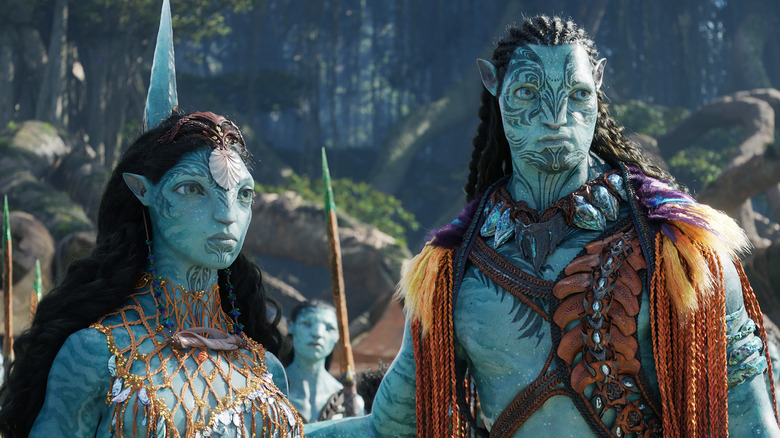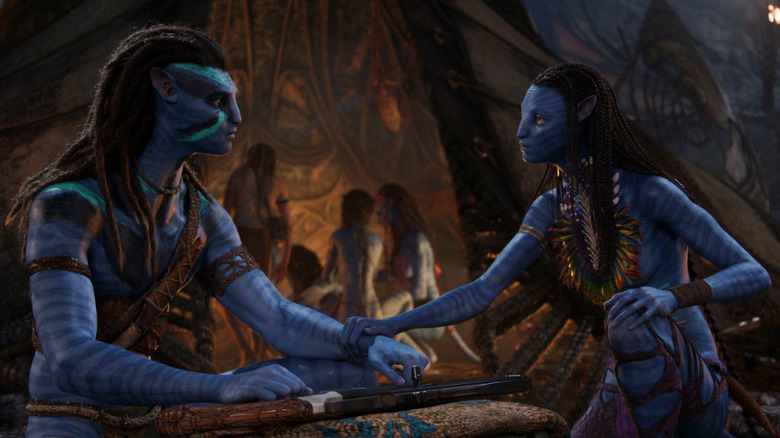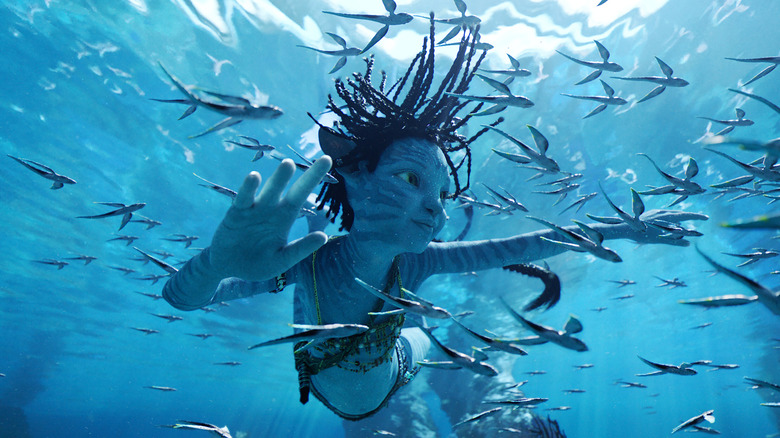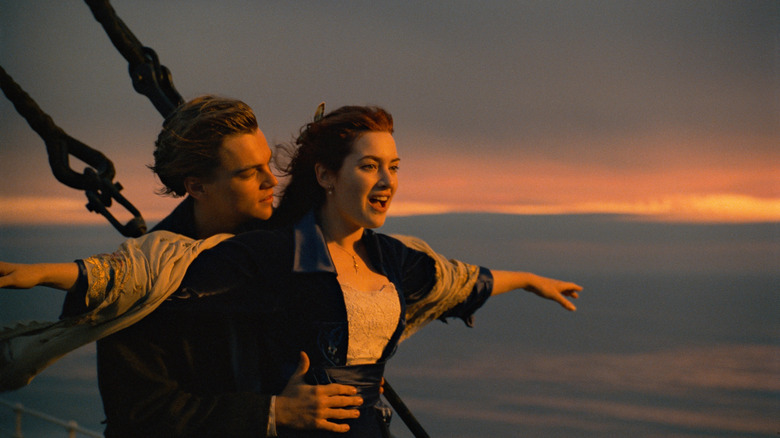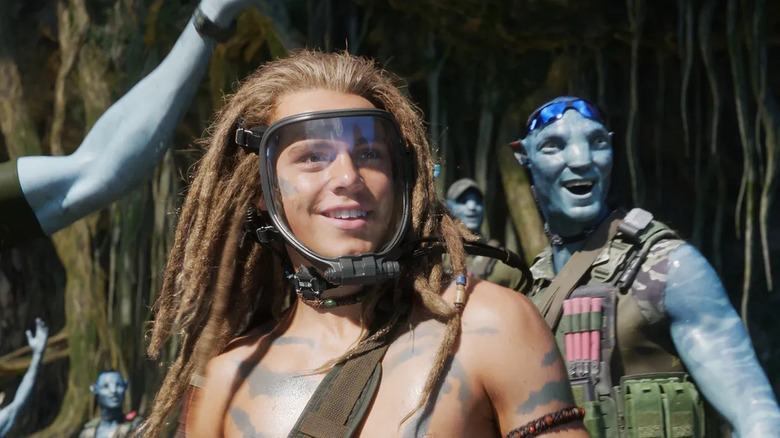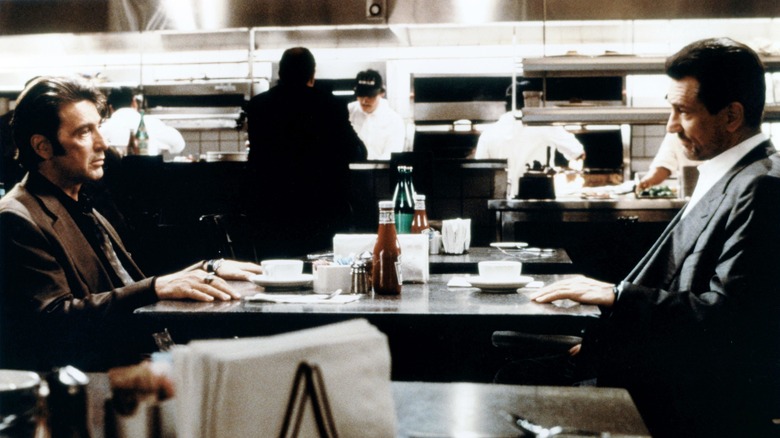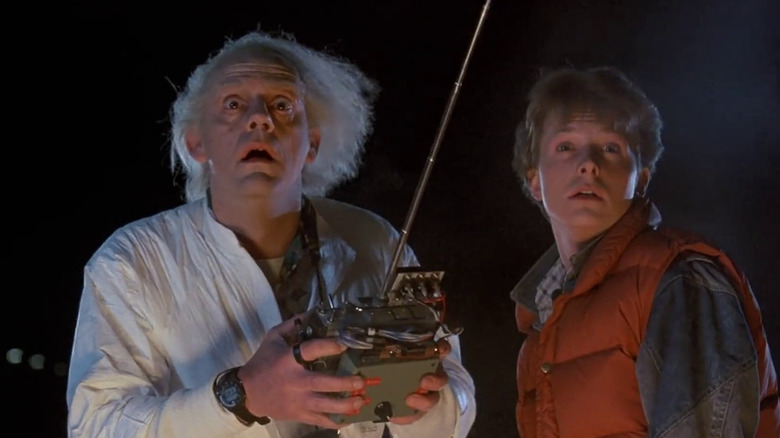Avatar: The Way Of Water Costume Designer Deborah L. Scott On A Brand New Frontier [Exclusive Interview]
Deborah L. Scott is pushing the envelope in the world of costume designing. Scott, who previously worked with filmmaker James Cameron on "Avatar" and "Titanic," built all the costumes for "Avatar: The Way of Water." While the physical versions of these costumes never appear on-screen, all of the actors were fitted so they would know how their characters would move underneath the weight and feel of the costume; Scott calls the process "virtual fittings." The costumes were later brought to life digitally, with Scott heavily involved in post-production.
The Academy Award-winning costume designer has spent the last five years working on the "Avatar" sequels, which she calls one of the most challenging and happiest times in her illustrious career. Scott's work is — no hyperbole — iconic. She's the costume designer behind "Back to the Future," "E.T. the Extra-Terrestrial," "Heat," and "Minority Report," to name just a few of her impressive credits. Recently, Scott spoke to /Film about her work on "Avatar: The Way of Water," and a few other highlights from her career.
This interview has been lightly edited for clarity.
'I want him to look like Clint Eastwood here'
What were the initial conversations about what you, James Cameron, and the team wanted to achieve on the sequel?
I want to say we started in 2018, but it could have been '17. It's been so long. I came in, the production designers had been there for quite some time, so working with Jim and doing all that laying the groundwork. Then, when I came in, it was a whirlwind because we were preparing for performance capture, designing the movie, and preparing for live-action, which is also designed. It was very, very busy.
We did have time to spend time together doing the world-building that we needed to do to lay the groundwork for all the design work that I was going to do on top of it. A lot of times, I think with Jim's movie, there's not very many descriptors in the script. So, we had the platform of the first movie as a jumping-off spot for at least Jake and Neytiri's clan. That was crucial, so at least you weren't just starting from scratch. We had to really build on that in terms of a clan, make it broader, bigger, family-oriented. They're older, time has passed, there are now teenagers and children. Then, start to hone in building the new clan, which is all brand new.
James Cameron said he wanted a little bit of Clint Eastwood for Jake this time, right?
That's his warrior self and it goes specifically to his costume piece, which is the leather poncho. You see it in film as they leave the forest and travel to the reef, he's got that on. It's a protective piece, and he was like, "I want him to look like Clint Eastwood here." So, we came up with that, and in his mind, those are the things that are related. I think it's because Clint had ponchos in some of those movies. That's going to stay with Jake into ["Avatar 3"] a little bit, so it'll get a little bit more airplay. That was the specific. He goes from being dad — he's softer, more approachable — into [being] just like Clint. He's going to get out there and fight the good fight.
For the time gap between film one and two, how'd you want to help express the passage of time for Jake and Neytiri?
It changed a little bit. Jake's pretty solid. When we went through the montage, I did the hair design as well, which was very gratifying because you get to complete the character head to toe, which is wonderful, because you can say a lot. In the beginning stages, he's very simple. He's just wearing his loincloth, his knife, he's not impressing anybody, he's not being a warrior. He's not trying to get out there and be Jake Sully at that point. He's got his dreads, he's let his hair go. He doesn't have the presentation as he does at the point in the movie where he decides to jump back in and defend the clan. When he does that, he puts his cummerbund back on, he shaves the side of his head, which reveals his stronger jaw, gives him a much more warrior-like influence.
Neytiri, Jim really liked the idea that as she became older, she was still a mother but she was also still her warrior self. The way that he chose to show stature in the clan for a female were these high necks, which doesn't have to be all the time, but it's a prominent in her character development. You see that as soon as she goes into the battle, she gets that high neck and she's back to being mom, wife, and warrior. It's an amazing combination because Neytiri never loses her femininity. She's always feminine, but she's powerful.
'It's complex, it blows your mind'
Something some audiences might not know is you make all the costumes.
Exactly.
How many costumes did you make exactly?
Well, obviously we made all the live-action costumes, including all those props, masks, the helmets, everything, that took about a year and a little more than that. That was pretty normal. Still a long time for filmmaking, because people make whole films in six weeks. Not this complicated, obviously. The Na'vi people and the digital, the virtual world, it's been five and a half years since I started, but I've also been designing ["Avatar 3"], so it's hard to delineate it.
As soon as we went into post-production, it's about two years worth of work, maybe three. You get into post-production with the digital house, and as you deliver all the costume pieces to them, all the drawings, all the reference material, all the shooting we did of costumes in water, on people, in the fan, and all those references, as you deliver it, then we spent probably over a year in post, maybe two years. You are fine-tuning and doing all the virtual work that you need to do so that the animation; the simulation is all appropriate to what the design of the costume is.
Those things, if they're meant to be light and breezy, they're light. If they're heavy-weighted, you can feel the texture, you can see the texture. That's part of the reason for making all the costumes, the props, and all the jewelry, because it lays out this 3D template. It's a 3D map for the animators and the simulators, and all the artists, because it's very difficult to get that kind of texture. We found that out in [the first "Avatar" movie], that you had to start building the things because they're dimensional. They have so much dimension, even though they're costume pieces, that you can't just draw. It's hard to get that three-dimension.
When you're talking to James Cameron and the VFX team about how they are going to shoot this costume underwater and how are you going to light this, how do the lighting choices affect the texture and colors you're going to use?
It affects it. Sometimes, that happens a lot later. This is where the fine-tuning comes in, because you get a costume maybe halfway through, where you're in motion underwater and the shot's from behind, and you need to figure out exactly how much fringe you're going to have on it. In the design and the making of it, if you still have time, you might be adjusting your materials so that it performs properly.
After the fact, you can fine-tune with adding or taking away, sometimes fine-tuning the color a little bit to be more complimented by the lighting. It's such a weird timeframe. In a live-action movie, you put your costume out there, it gets lit, and you're like, "Well, okay. Jeans, they look dark here, they look light here." You accept all those, your eye accepts all that, right? It's normal.
This is such a high-tech, high-concept world. That's what's wonderful about it, that you can continue tweaking after the fact. So, there's a top of Kiri's that I built mostly in reds. When we got it into the lighting situation for the first time, Jim and I looked at it and he wanted a color change. You can do that in the virtual world. We tweaked it to be mostly greens, and it was the polar opposite. That's where the work continues, and that's part of the reason why it takes so long. It takes maybe 200 hours to hand-build a top, but you can continue working on it.
I have so many follow-up questions.
It's complex, it blows your mind. It's hard to talk about it because there are so many levels.
'We had to go back and do it so many times to get it perfect'
James Cameron has said for the incredible sunset for the iconic moment in "Titanic" that he'd just do green screen instead now. It does raise the question, what about the magic of imperfections and real variables? Do you have that question of, how do we maintain these imperfections that make these costumes and this world believable?
I think that's where you have to use your eyes and your experience, from being, for me, a costume designer for so many years. Your automatic response seems to be control and perfection. There was one time, I remember, we were looking at an arm band, and they have to be tight enough so that it makes sense that they don't fall down the arm and whatnot. We were looking at one that was a little bit wobbly, and I thought, "You know, that's exactly what would happen in real life." Things aren't perfect all the time. In that imperfection is where reality starts to bloom, because if it's too perfect, it might as well be a cartoon. But the fact is, that sometimes the wind is going to blow the fringe on the costume this way or that way. You're not going to be able to control everything, and you want it to be real.
I think when Jim talks about that shot in "Titanic," it's because we had to go back and do it so many times to get it perfect. There's the splendor of it, the reality of it, and you feel it even though you weren't there. I think in a movie like "Avatar: Way of Water," the immersion that we have with these characters — and their clothing, for me — that you almost feel you could reach out and touch it, it's so real. That's so important, because that's how humans and Na'vi relate to each other. We're very tactile, our visual sense is very acute. Those things work, really, hand in hand. I think in this 3D world, it's super-important to be as real as possible. Jim's a proponent of that 100%.
You've worked with so many of the cutting-edge filmmakers, so did you ever imagine costume designing was going to reach this place?
No. I've been saying this for the last few months. Once we came out of hibernation making the movie, you get so hyper focused on it, but then when I'm able to step back, I'm like, "This is a brand-new frontier for costume designers." We haven't been either allowed into that process or necessary in that process, but we are now, because we help with everything. The performance capture is super-important. The reference of these things, like going on the set, putting a costume on a body, making it perfect, and walking away.
We are developing the underwater wetsuits for the performance captures. That was brand new. Jim requested that I stay on through post to make sure that all of the things we wanted to do with the costume design, the motion, the color, all those things be respected and important to the finished product. For costume designers across the board and costumers, this is like, "Welcome to this whole new world." We deserve to be in there with everybody else, because it's important to the character development and everything else.
How does the high-frame rate affect your work? You can't hide anything, right?
No, that's why it has to be so real. The costumes, I got to say, if you saw them in person, if we ever get a chance to actually get them out there in person, they're absolutely gorgeous. Not to toot my own horn, I'm actually saying the people, the makers, the people who hands-on spent hours and hours making each and every thing, it comes across. You see that. It's important that it had been like that.
Knowing that this intense 3D world, 4K, all this stuff is going to amplify that, it literally almost has to be perfect. But in saying that, each piece is unique and different to each other. There's only one, there's one of those things. That one thing has to be translated through this virtual world, and come out exactly like you wanted it. It's a long, involved process and it requires a lot of artists all along the way, with me guiding it to make sure it gets there.
'I trust his vision, he trusts me to deliver that vision for him'
With James Cameron, who has an engineer's mind, what are the notes like for how to make a mask both cinematic and practical?
Well, that's really hard to do because I'm not an engineer, so I have to rely on other people to be engineers for me. But the mask thing, it's a tremendous amount of work for not that much payoff, in a way. Everyone accepts the fact, from film one, that they wear masks. The mask in ["Avatar"], Jim was frustrated with them because people couldn't wear hats. The humans, they couldn't wear a hat. It wouldn't work together. We struggled with that on film one.
By the time I came on ["Avatar"], the masks were already done. I got the joy of redesigning, updating those, but we had that as the template. We made a little artistic change, but we tried to follow that pretty truthfully. Then we expanded, like there were hospital masks and construction masks, and the construction mask had to fit with a construction helmet. So, they all evolved, and I think it got much more real and important when we went to the dive masks, because he really put people in the water in those masks. I worked closely with a man named John Garvin, who ran all of our water-tank work and all that. He supervised dives for Jim, his submarine, and so he knows it.
We worked very closely with, "Okay, what's the artistic, creative part that I could do, and what's the practical, real part?" Because you're going to put that kid and other people, put that 15-year-old boy 30 feet down, it's got to work. It's got to be safe. So, he had to carry air tanks, and there were a lot of finagling around, but that was a real deal. Jim says now that there are actual people in the dive world that respect that mask, so that's a success.
I like to imagine him talking about those subjects over coffee, like, "You know, when I was down in the Mariana Trench..."
[Laughs] "Oh yeah, me too." Yeah, he's pretty involved in a way that I am not, and luckily he respects what I do to bring him stuff that he's not familiar with. He'll be the first one to say, "I don't know anything about clothes," but he knows what's right and he knows what he likes. He has an incredible visual eye.
How did you both initially click artistically?
I think because the most important thing with Jim is to remember that, aside from all of the things that he does miraculously well, he's a really hard worker. He works at a level, and he demands all of his department heads, all the people on his crew, to work at that level. As soon as he understands that you're going to work at that level, and you're going to deliver on a level that he wants you to, he supports you to get there. I think when that became evident, then we knew there was pretty much nothing we couldn't accomplish together, so that it's beautiful, it's creative, it's all these wonderful things. It's also practical, because of the amount of testing I had to do on each garment, to make sure it reacted in the situation exactly how he wanted it to. For him, you have to have trust. I trust his vision; he trusts me to deliver that vision for him. It's that unexplainable moment when you get there, that you're going to be in the same playing field, you're going to give him what he needs and he wants, and that you're going to operate at a level that's of the highest he can find.
Would you say your collaborations with Steven Spielberg, Michael Mann, and Robert Zemeckis are similar experiences?
Absolutely. It's just different. Each film is so different. Working on "Heat" with Michael Mann, there's the reality factor. It's also the creative things, but he's a stickler for absolute precision. Steven is a master of creation. He creates these worlds. You start big and then you hone down, in a way. But yeah, they're just gigantic filmmakers. They're very precise, they're very artistic, and they can't have a weak link in their chain. It doesn't work like that. You're hired to bring your part to the party.
'Well, you know it's a suit world, right? You accept that'
As much as we talk about the technical side, this is a movie about family. In your Oscar speech, you thanked your family for inspiring you. So, how does family inspire you and your choices when you work on "Avatar: The Way of Water"?
Yeah, it's extremely personal because as a costume designer, you're building character, but you're also helping the narrative of the story. So, it's important that they ring true, that even in a fantastical world like Pandora, you have the basis of a unique individual in a time and place. I think Jim talks about this too, raising children. Since "Titanic," my kids were little, now they're adults.
Going through all that, and seeing all that interaction, and crisis, and dysfunction, and wonder, and beauty that a family has around it, it's important for us to remember that. It just channels through. Things like Lo'ak being the rebel son because the firstborn is the golden boy. Jim likes these classic delineations. So with Lo'ak, it was like, "Well, we're going to shave the side of his head. Doing the hair design made it so important, those braids that come down, so that he can react to it." They work hand in hand with the performance, with his character, the nature of that boy in that time.
There's so much to discuss, and obviously, I do want to ask a bit about your past work. You mentioned "Heat." For that film, how'd you want to help define Al Pacino and Robert De Niro's characters?
Well, you know it's a suit world, right? You accept that. It's going to be a suit. Michael Mann really wanted to exemplify the differences, even though they're both wearing shirts and suits, and it's quite like that. De Niro's character comes out of the prison system, basically. He's so precise. That guy's like, a crisp white shirt, not a wrinkle. We went through maybe 100 gray suits to get to that one. It's like, that was the one, and then we tailored it to make it even more [right]. He was pretty much no frill. He didn't have jewelry. He was sharp and clean. Pacino, he automatically brings more motion to his characters, in a way. De Niro can be quite still, and was unbelievably focused in "Heat." Just an incredible performance. Pacino could slump back and do the things, his Pacino thing, and his clothing was dark and moody, and he had, really, a signature ring that we found for him, that he really clung to. But that difference and yet similarity, you take the same items, a shirt, a suit, a pair of pants, and you just go absolutely opposites in terms of character development.
Your imagination runs wild on "Minority Report," and yet, still keeps two feet in reality. That's such a great movie, by the way.
I know. Both of those movies really hold up. I think that the technology even, in "Minority Report," is fantastic. It's a brilliant piece of writing. The characters are amazing. Tom is as equally focused as Pacino and De Niro. He's just a laser beam. I think in that film, he was allowed to show a lot of emotion that we don't often get to see.
I agree.
It's a really good performance, but one of the things that was different about that, that it was more of a fantastical world, but we based it, again, in reality. What I did, when I started off designing that movie, there are three parts of society. There's Tom Cruise, there's the authoritarians, and then there's the underground people. I used three different illustrators with different styles, so that you could get this feeling organically. Tom Cruise is the real world, they're slick, they were minimal designs based with an artist that was much more of a fashion illustrator. So, it's a little gestural and very simple. The authoritarian world is kind of like the '60s. Max von Sydow's world, it's very based on a '40s thing, old movie star, classic shapes, classic colors. I used a different illustrator for that, that was just more a realist. Then, the underground world with all these crazy characters, it was just that you needed more of a completely unique way of drawing and presenting the fact that you're going to take ... It's just a mishmash of stuff. We got to be as crazy as we could get, but contained and real too.
I love that you brought such film noir to it. Colin Farrell's suits in that movie are terrific.
Yeah. He fits right in that center, that sharp, double-breasted suit. He obviously can carry it off. He has that physique and stature to just be clean. There's a lot of clean in that movie, that juxtaposes with the underground.
'The response to that, Michael J. Fox in that orange vest, it's crazy to me'
When did you realize your costumes for "Back to the Future" became iconic?
When people start emulating it or talking about it. The response to that, Michael J. Fox in that orange vest, it's crazy to me. You are like, "Really?" It's so gratifying. Then of course, the toy market, the franchise market helps. It's like with "ET" or "Back to the Future," these iconic moments where a lot of things have to align.
You have to have an incredible movie, you have to have a brilliant performance, and you have to have that moment in the film that makes it shine, that gives it that life. People need to love that movie. Then, everything just aligns. Then all of a sudden, if you go to a screening of "E.T.," there's a lot of people wearing red hoodies in the audience. I think audience members, we all love to identify with the film. If you don't identify with it in some way, then the film doesn't cut it for you.
It's that collective unconscious, that everyone gets together, and then they pick a signifier. Jim and I talked about it the other day with Kate [Winslet], in an interview about "Titanic," with Kate coming out of the car. What better tribute can you have to a costume than Jim starts the shot on her feet and you just go all the way up. You see in that moment it sets the character and gives this purpose to the movie. That's a more focused intention, but all these things still have to come together. It had to be the luminous Kate Winslet under that hat, obviously. She's beautiful. It's very gratifying. It's unexplainable. You can't predict it, and you can't make it happen.
Deborah, thank you so much for discussing your work with me.
My pleasure. Thank you so much. We could talk forever about this stuff.
I know. Talk to you in a few years for "Avatar 3."
Absolutely. Hold on to your hat, because "Avatar 3" is amazing.
"Avatar: The Way of Water" is now playing in theaters.
